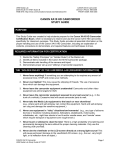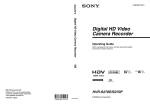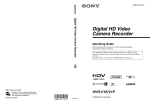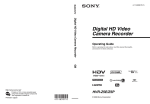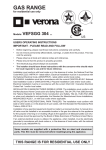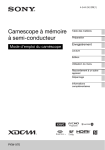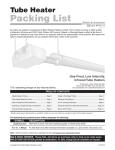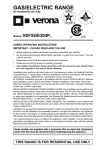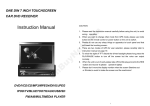Download SONY HVR-V1U HDV CAMCORDER STUDY GUIDE
Transcript
UHM Media Lab 2350 DOLE ST. KHET Studio B WEB SITE: http://www.communications.hawaii.edu/mlab/about.htm Sony HVR-V1U HDV Camcorder Manager’s Phone: 956-3358 FRONT DESK: 956-3355 SONY HVR-V1U HDV CAMCORDER STUDY GUIDE PURPOSE PURPOSE This Study Guide was created to help Communication students to prepare for the HDV Camcorder Certification exam, which is necessary to reserve and use the HDV remote equipment, specifically for classroom purposes. This Study Guide provides all essential information on the proper handling and use of the remote HDV equipment, including an explanation of contents, procedures to demonstrate, and required features and techniques to know. "THE “GOLDEN RULES” OF THE UHM MEDIA LAB (REQUIRED KNOWLEDGE) 1. Never force anything! If something you are attempting to do requires any amount of excessive force, STOP and review your methods. 2. Never over tighten! This may cause the stripping of threads. The use of excessive force which can damage the equipment. 3. Never leave the camera equipment unattended! Camera and other video equipment are prime targets for theft. 4. Never leave the camera equipment exposed to any heat source! e.g. - in the trunk of a vehicle. Heat can cause tape to stretch. Excessive heat will cause camera parts to melt. 5. Never take the Media Lab equipment to the beach or near shorelines! e.g. - where sand and salt air/spray can contact the equipment. Sand and salt air/spray can clog and damage the sensitive equipment. 6. Never use equipment in “risky” situations/environments**! e.g. - any type of airborne devices or locations including airplanes, helicopters, skateboards, motorcycles, rollerblades, etc., night time shoots in low lit and/or unsafe areas, and “remote” areas which require transport of equipment over rough terrain. 7. Never touch or attempt to clean the lens! There is a high probability of scratching and permanently damaging the lens without the proper cleaning materials. Only use the cleaning cloth provided. 8. Never aim the lens, the viewfinder, or the LCD screen directly at a strong light source! This will cause permanent damage to the viewfinder/LCD screen. (e.g.- the sun, very bright light, or its reflection from an object.) Sony HVR-V1U HDV Camcorder UHM Media Lab Tutorial Updated 8/16/07 1 UHM Media Lab 2350 DOLE ST. KHET Studio B WEB SITE: http://www.communications.hawaii.edu/mlab/about.htm Sony HVR-V1U HDV Camcorder Manager’s Phone: 956-3358 FRONT DESK: 956-3355 REQUIRED SKILLS AND KNOWLEDGE FOR CERTIFICATION Locate and identify the following items included in the HDV CAMERA PACKAGE plus the optional WIDE ANGLE CONVERSION LENS kit 1) Tripod Carry Case 2) Sachtler Tripod 3) Camera Bag 4) Shotgun Camera Mic 5) SONY HVR-V1U HDV camera 6) Battery #1 7) Battery #2 8) AC Adapter 9) AC Adapter power cord 10) Camera “Operating Guide” manual 11) Audio Headphones with pouch 12) AC power cord/cable 13) AC power strip 14) AV connecting cable OPTIONAL WIDE ANGLE CONVERSION LENS KIT 15) Wide (Angle) Conversion Lens 16) Wide (Angle) Conversion Lens Hood 17) Wide (Angle) Conversion lens pouch Sony HVR-V1U HDV Camcorder UHM Media Lab Tutorial Updated 8/16/07 2 UHM Media Lab 2350 DOLE ST. KHET Studio B WEB SITE: http://www.communications.hawaii.edu/mlab/about.htm Sony HVR-V1U HDV Camcorder Manager’s Phone: 956-3358 FRONT DESK: 956-3355 Identify the following Tripod parts: 1) Tripod head 2) Balance Plate Lock 3) Tilt Lock 4) Tilt DRAG 5) Pan Lock 6) Pan DRAG 7) Counter Balance Spring 8) Pan Handle Clamp Screw 9) Bubble Level 10) Safety lever for Wedge Plate Release Lever 11) Camera Wedge Plate Release Lever 12) Pan Handle 13) Tripod Head Lock 14) Tripod Legs 15) Leg Locks 16) Tripod Extension Legs 17) Spreader Locks 18) Tripod Speader 19) Buckles Sony HVR-V1U HDV Camcorder UHM Media Lab Tutorial Updated 8/16/07 3 UHM Media Lab 2350 DOLE ST. KHET Studio B WEB SITE: http://www.communications.hawaii.edu/mlab/about.htm Sony HVR-V1U HDV Camcorder Manager’s Phone: 956-3358 FRONT DESK: 956-3355 DEMONSTRATE the following Camera procedures: Setting Up the Sachtler Tripod 1. Loosen, extend and re-tighten the tripod legs. Spread the tripod legs equally in one motion. Pulling out one leg at a time will break the spreader. 2. Lock the tilt lock and pan locks, loosen the head lock, and adjust use the bubble level indicator to level the tripod head. Re-tighten the head lock. 3. Mount the camera on the tripod. (Before mounting the camera to the tripod, make sure that the tilt lock and pan lock are locked and all leg extensions are secured so that the tripod does not move or collapse when mounting the camcorder. 4. Demonstrate safety procedure. Always double check tripod stability prior to mounting the camcorder. IMPORTANT NOTE: To avoid potential accidents with tipping the tripod over, never leave the camcorder unattended, especially when tripod head (tilt lock) is in an unlocked position. ALWAYS BE AWARE OF THE STATUS OF THE TRIPOD! To avoid internal damage to the tripod head, never force a pan or tilt when the tripod head is in a locked position. Also, always lay the tripod down when it is collapsed and not in it’s carrying case. Tripods leaned against a wall or chair often fall over and end up with broken parts on the head. Setting Up the HDV Camcorder Unit Demonstrate how to safely mount and release the HDV Camcorder on the tripod. From the back of the Tripod, slide the camera wedge plate onto the tripod head. With your free hand pull the wedge release lever to the left while pushing up the lock lever. Carefully check that the camera is securely mounted to the tripod. IMPORTANT NOTE: The Pan Lock should always remain unlocked after the camera is secured to the tripod head to prevent the accidental tipping over of the tripod if the panhandle is accidentally pushed. Hook up the AC power adapter and install and eject battery power. To avoid pulling over the camera, start by working from the wall to the camera. Plug the extension cord into the wall. Plug the power strip into the extension cord, making sure the power strip is turned off. Plug the AC power adapter into the camera [f] (see picture on page 9). Connect the AC cable into the adapter and the power strip. Turn on the power strip. Turn on the camera by pushing in on the lock release button on the power switch and rotating the switch to point at the CAMERA designation. To install a battery, turn off the camera, remove the AC adapter, lift the viewfinder. Insert the battery pack with the arrow mark on the battery pack facing down. Slide the battery pack down until it is locked or you hear a "click" sound. Now you can turn on the camera. To remove the battery, turn off the camera, lift the viewfinder. While pressing the Batt Release button, slide the battery pack up. CAUTION: If the battery pack is removed during recording or playback, the tape remains wound around the video head cylinder and could become damaged. This is also the case during the loading and unloading of the tape. Keep the power connected until the camera is switched off and completely shut down. NOTE: When the AC adapter is plugged into the camera and the camera is turned off, the battery on the camera will be charged. A small yellow on the camera indicate that the battery is charging and it goes out when the battery is fully charged. Sony HVR-V1U HDV Camcorder UHM Media Lab Tutorial Updated 8/16/07 4 UHM Media Lab 2350 DOLE ST. KHET Studio B WEB SITE: http://www.communications.hawaii.edu/mlab/about.htm Sony HVR-V1U HDV Camcorder Manager’s Phone: 956-3358 FRONT DESK: 956-3355 Explain in what situations AC or battery power is used. Batteries should be used for mobility such as when the camera is handheld or used for short periods of time before setting up again. AC power should be used for extended setups when camera is to be set up in one place for an extended period. Making manual adjustments to the camera settings A. AUTO LOCK 3 position switch, set to middle position up: All functions in automatic mode middle: Functions may be switched to manual mode (Desired position for Media Lab students) down: Manually set functions locked into position B. GAIN button: Increases light sensitivity of the camera with a corresponding increase of video noise. Press button when exposure is in AUTO mode and turn dial [F] to adjust level. C. SHUTTER SPEED button: Adjusts shutter speed. Press button when exposure is in AUTO mode and turn dial [F] to adjust shutter speed. D. WHITE BAL button: Adjusts white balance. Press button and turn dial [F] to select 1 of 4 options. 1. A: Fill the frame with a white card, press the dial to set the white balance 2. B: Fill the frame with a white card, press the dial to set an alternate white balance 3. Black Dot: A preset outdoor white balance setting (5600K) which may be adjusted 4. Bulb: A preset indoor white balance setting (3200K) which may not be adjusted E. MENU button: Push to access the camera’s menu system. Push again to exit the menu. F. SEL/PUSH EXEC: Rotate and push to navigate the menu system. Mount the shotgun camera microphone to the HDV camcorder. 1. Open the shotgun mic clamp [G]. Place the shotgun mic in the holder and secure the mounting screw. 2. Attach the cable to the built-in strain relief slot [H] 3. Plug the XLR connector into the XLR input [I] 4. Mic/Line setting. a. Push the camera “MENU” button [E] to select the camera’s internal menu b. Navigate the menu system by turning the “SELECT/PUSH EXEC” dial [F] and pushing it to make the selection c. Make the following selections: AUDIO SET; DV AU.MODE; FS48K AUDIO SET; XLR SET; AU. MAN GAIN; SEPARATE AUDIO SET; XLR SET; INPUT 1 LEVEL; MIC (for microphones) or LINE (for other audio devices) AUDIO SET; XLR SET; INPUT 2 LEVEL; MIC (for microphones) or LINE (for other audio devices) NOTE: You must be able to explain the difference between MIC level and LINE level. MIC level is the weak audio signal put out by microphones. LINE level is a strong audio signal put out by devices such as CD players and audio mixers. The settings of the input connector must match the device being used. Sony HVR-V1U HDV Camcorder UHM Media Lab Tutorial Updated 8/16/07 5 UHM Media Lab 2350 DOLE ST. KHET Studio B WEB SITE: http://www.communications.hawaii.edu/mlab/about.htm Sony HVR-V1U HDV Camcorder Manager’s Phone: 956-3358 FRONT DESK: 956-3355 AUDIO SETTINGS: Set and explain the functions of the following audio switches: 1. The REC CH SELECT switch [J] This switch determines how the audio from audio INPUT1 and INPUT2 are routed and recorded in the camera. CH1-CH2 [1] mixes audio to Channel 1 only… nothing is recorded on Channel 2. CH1 [2] allows audio to be recorded separately… INPUT1 audio is recorded on Channel 1 and INPUT2 audio is recorded on Channel 2. 2. AUTO/MAN switch [K] AUTO: [3] Automatically adjusts the audio recording level MAN: [4] Allows manual control over the audio recording level with the AUDIO LEVEL dial [M] 3. +48V (PHANTOM POWER) switch. [L] The supplied shotgun mic is a condenser mic and needs electrical power to function. Electrical power supplied by the camera is known as PHANTOM POWER. ON: [5] Provides phantom power to microphone through the audio input connector OFF: [6] No power CAUTION: Some mics may be damaged if phantom power is supplied when it is not needed. 4. AUDIO LEVEL dial. [M] Rotate to adjust the recording level of the audio signals from the audio inputs. 5. Set audio recording level Open the LCD PANEL on the side of the camera. Push the STATUS CHECK button [U] and select the “AUDIO” display by rotating the menu dial [F]. Set the audio recording level so that the meter indicates an average level between 30 and 10 in the meter readout. You can also monitor audio by cycling through the DISPLAY/BATT INTO button [Q] and using the smaller audio monitor in the viewfinder. The audio recording level is set too high if it touches the red bar and audio distortion will occur. 6. Attach the headphones to monitor the audio The headphone jack [S] is located under the guard cap on the back left side of the camera. Use a headphone with a 3.5 mm stereo mini jack only. 7. Headphones Volume Control [O] Push “+” to increase the volume to the headphones and “-“ to decrease the volume. Note: You must understand the difference between recording level and volume level. Recording level is the setting at which the audio recording is made and volume level is the setting for loudness in the headphones or speakers. Adjusting the recording level will also change the loudness in the headphones, but adjusting the volume for the headphones has no effect on the recording level. Sony HVR-V1U HDV Camcorder UHM Media Lab Tutorial Updated 8/16/07 6 UHM Media Lab 2350 DOLE ST. KHET Studio B WEB SITE: http://www.communications.hawaii.edu/mlab/about.htm Sony HVR-V1U HDV Camcorder Manager’s Phone: 956-3358 FRONT DESK: 956-3355 LENS AND EXPOSURE CONTROLS: V. LENS HOOD SHUTTER: Push up to open lens hood shutter, down to close W. FOCUS ring: Rotate to focus lens manually. X. ZOOM ring: Rotate to zoom lens manually. Y. EXPOSURE/IRIS button: Push to change between automatic and manual exposure modes. Z. EXPOSURE/IRIS dial: Rotate to adjust exposure in manual mode. a. ND FILTER: 3 position switch changes the amount of light that passes through the lens. An ND (neutral density) filter has no effect on the color of the light. Each adjustment changes the exposure by approximately 2 F stops (effectively doubling or halving the amount of light) b. PUSH AUTO FOCUS button: One touch button focuses lens automatically when held down. c. EXPANDED FOCUS button: Push to digitally zoom into the center portion of the scene for greater focusing accuracy. Does not work when camera is recording. d. FOCUS button: Push to switch between automatic and manual focusing modes 3 ways to make zoom adjustments to the lens Servo: For motor driven zoom operations there are 2 options 1) The variable power zoom rocker lever on the handgrip 2) The power zoom rocker lever on the top handle with a switch to select 3 different settings: off, slow zoom, and fast zoom Manual: For manual zoom operations grab the zoom ring and rotate it. NOTE: The zoom ring does not work when lens is being zoomed with the servo controls. The zoom ring may also exhibit some control lag. Complete procedure for setting WHITE BALANCE 1. Select an appropriate ND filter [a] for proper exposure of the scene. The viewfinder will flash with an ND indicator setting if there is too much or too little light. 2. Put the camera AUTO LOCK [A] into the middle position. 3. Push the WHT BAL button [D]. One of four white balance symbols will appear in the bottom right corner of the viewfinder. 4. Select white balance symbol “A” 5. Put a white card in the scene you are about to shoot and zoom in on the card until it fills the frame 6. Put the camera exposure setting into automatic mode 7. Press and release the SEL/PUSH EXEC button [F] 8. The camera is now white balanced to the scene and the information is stored in MEMORY A. (An alternate scene may be stored in MEMORY B using the same method with symbol “B” Sony HVR-V1U HDV Camcorder UHM Media Lab Tutorial Updated 8/16/07 7 UHM Media Lab 2350 DOLE ST. KHET Studio B WEB SITE: http://www.communications.hawaii.edu/mlab/about.htm Sony HVR-V1U HDV Camcorder Manager’s Phone: 956-3358 FRONT DESK: 956-3355 selected.) 9. Put the camera into manual exposure mode for proper exposure setting Understanding WHITE BALANCE: Light consists of 3 different primary colors. The balance of these different colors can shift depending on the light sources and environment. A video camera is usually more sensitive to these differences than the human eye. When the camera is white balanced on a white card, the card will be white in the video and all other colors will appear normal. A white balance “SUN” symbol is set for an approximation of outdoor light with the sun shining at noon (5200K). A white balance “INDOOR” symbol is set for an approximation of TV studio or stage lighting (without colored gels) (3200K). Standard procedure for setting the correct exposure 10. Set the Push the EXPOSURE/IRIS button [Y] to switch to manual control of the exposure 11. Rotate the EXPOSURE/IRIS dial to set the proper exposure 12. Use the ZEBRA switch [P] to assist in setting the proper exposure *When the ZEBRA switch is set to 100, images that are over exposed lose their color and definition and go totally white and have a “zebra pattern” on them in the viewfinder. *When the ZEBRA switch is set to 70, a human face is properly exposed when a “zebra pattern” just starts to appear on the face in the highlighted areas, it is especially noticeable between the brows and on bridge of the nose. 13. Use additional lights and reflectors to achieve proper exposure in high contrast lighting situations. For example, shooting a person’s headshot for an interview with the sun behind them and sky as background… if the sky is properly exposed, the face will be too dark and if the face is properly exposed, the sky will be “blown out’ to white plus the face will often shift to a reddish tint. Adding more light to the face will help balance out the brightness of the sky. Standard procedure for setting time code Time Code is set in the menu system “TC/UB SET” 14. Push MENU button [E], rotate SEL/PUSH EXEC dial [F] and push to select your choices 15. Select and push TC/UB SET: TC PRESET: PRESET: set to 01:00:00:00: OK: OK 16. TC FORMAT: DF 17. TC RUN: REC RUN 18. TC MAKE: PRESET Understanding TIME CODE: TC FORMAT: DF DF stands for Drop Frame. DF time code eliminates (or drops) 2 time counted th frames (0 & 1) every minute, except for every 10 minute to synchronize the time code with real time. Although 30 frames are considered to be one second in time code processing, the actual frame rate is 29.97 frames/second. As a result, the time code gradually lags behind real time as the recording gets longer. The drop frame function adjusts the time code to match the real time. TC FORMAT: NDF Without dropping time counted frames (known as NDF or Non-Drop Frame mode) our time code will read 1 hour, but in real clock time it would equal that of 1 hour and 3.6 seconds (108 extra frames of video). (When shooting in 24P, the non-drop frame mode is established regardless of this item's setting.) To learn more about setting Time Code refer to pages 78-79 of user manual. TC RUN: REC RUN Record run is the advancement of time code only when recording video. With this setting, 1 hour of time code yields 1 hour of video on tape. TC RUN: FREE RUN Free run will advance the time-code continuously whether recording or not. This method is often chosen to match the time during the day when the recording was made by synching the time code with the time of day. TC MAKE: PRESET Allows the camera operator to set the time code which is to be recorded at the beginning of the tape. After that, the last recorded time code becomes the time code when recording restarts. TC MAKE: REGENERATE: recording proceeds in such a way that the time code continues (is regenerated) from the time code on the tape. However, it must be cued to that video and time code. Sony HVR-V1U HDV Camcorder UHM Media Lab Tutorial Updated 8/16/07 8 UHM Media Lab 2350 DOLE ST. KHET Studio B WEB SITE: http://www.communications.hawaii.edu/mlab/about.htm Sony HVR-V1U HDV Camcorder Manager’s Phone: 956-3358 FRONT DESK: 956-3355 Using ASSIGN buttons [R] [e] ASSIGN buttons can be used to trigger certain functions of your choice. These assignments are made in the MENU system. The Media Lab suggests that 3 buttons assume the following functions. You may use the other 3 assignable buttons for functions of your choice. 1. COLOR BARS changes the video input to color bars 2. RECORD REVIEW allows you to view the last 2 seconds of the last recorded scene 3. END SEARCH cues up the tape to the last recorded video Attaching the AV CABLE You can monitor video on a standard (4:3) monitor using this cable (see item #14 on page 2). Plug it into the back of the camera [e], above the external power connector [f]. Loading videotape Use only SONY brand videotape! All other brands are not recommended due to incompatibility issues. SONY Digital Master or DVCAM tape is recommended, although consumer grade SONY tape will work if necessary. Slide and hold the OPEN/EJECT button on the top of the handgrip and pull open the lid. Wait for the cassette compartment to open up. Insert video cassette with it’s window facing out, then press where it says “PUSH” on the side of the compartment. Close the handgrip lid and you are ready to begin taping. Tape playback After recording video, press the green button on the camera power switch and move the lever to the VCR mode. Use the VCR control buttons [N] to rewind and playback the video on the tape. Use “END SEARCH” to re-cue the tape to the last video. Attaching optional WIDE ANGLE CONVERSION LENS [E]+[G] 1. When the camera is mounted on a tripod, tilt it upwards and lock the pan and tilt locks (do not point the camera into the sun or a bright light source) 2. Remove the camera lens hood (loosen the lens hood fixing screw and turn the lens hood counterclockwise an 1/8 turn and pull off) 3. Remove (unscrew) and store camera lens protection filter 4. Attach WIDE ANGLE CONVERSION LENS [g]: align marks on WA (Wide Angle) lens and top of camera lens, slip WA lens [g] over camera lens and rotate clockwise about 1/8 turn until it locks into place 5. Attach WA CONVERSION lens hood [i]: Loosen WA hood locking screw [j], align marks at the top, slip hood onto lens and tighten locking screw [j] 6. Removal is this process reversed except that the WA lens locking button [h] must be pushed to release and turn the WA lens. Sony HVR-V1U HDV Camcorder UHM Media Lab Tutorial Updated 8/16/07 9 UHM Media Lab 2350 DOLE ST. KHET Studio B WEB SITE: http://www.communications.hawaii.edu/mlab/about.htm Sony HVR-V1U HDV Camcorder Manager’s Phone: 956-3358 FRONT DESK: 956-3355 Check important camera settings before shooting begins. NOTE: The Media Lab staff will not be responsible for any settings of the camera. The students will be responsible for setting up the camera for their use. The following are recommended settings suggested by the Media Lab. Consult your instructor if you have any questions about the proper settings for your class. 1. REC FORMAT: DV | DV REC MODE: DVCAM | DV WIDE REC: OFF | This is the Media Lab’s currently recommended video format setting (consult your class instructor) 2. Audio format: 48HZ 3. AU. MAN GAIN: SEPARATE (Allows manual audio controls to adjust audio record levels separately for channels 1 and 2) 4. STEADYSHOT: OFF (Off when mounted on a tripod but may be useful for handheld shots) 5. PICT. PROFILE: OFF 6. ASSIGN BTN: ASSIGN4:COLORBAR | ASSIGN5: REC REVIEW | ASSIGN 6: END SEARCH 7. Time code: “TC FORMAT” to “DF” (drop frame); “TC PRESET” to 00:00:00 or 01:00:00 at start of tape (or set “TC MAKE” to “REGENERATE” and cue up the end of the last recorded video to record a continuous time code. 8. Record 30 seconds of color bars at the beginning of the tape. Standard procedures to begin shooting video Preset camera: 9. Turn on camera and set all important settings such as audio and video format choices, scene profiles, time code preferences, etc. 10. Set personal camera preferences such as headphones volume, LCD panel brightness, viewfinder diopter adjustment, etc. 11. Put tape in camera and rewind if tape was previously used 12. Turn on and record 30 seconds of COLOR BARS Setup for shooting video on location 13. Hook up microphones to be used 14. Set proper audio recording levels and monitor with headphones 15. Set proper ND filter selection 16. Zoom in and focus on a white card in front of the subject matter 17. Set exposure to AUTO and set white balance with white card 18. Focus lens on subject matter in manual mode for maximum sharpness 19. Zoom back to compose scene to shoot 20. Set exposure to manual control and adjust for proper exposure 21. Record video while monitoring audio with headphones 22. Stop recording and check recorded video with REC REVIEW function “Striking” / Packing the HDV Camcorder Unit and Sachtler Tripod A. Demonstrate how to “strike” the HDV Camcorder unit when the video shoot is finished • The tape must be remove, the camera turned off, and the battery must be removed • The wide angle lens must be removed and stored correctly and the camera protection filter and lens hood must be reattached, the lens hood shutter should be closed • The AC cord must be coiled in the “over/under” method of coiling. (All audio and video cables must be coiled in the same manner to prevent twisting when unwound.) • All items must be neatly packed in their proper locations B. Demonstrate how to “strike” the Sachtler tripod. • The spreader extensions must be retracted and locked • The tripod legs must be retracted and locked • The legs must be collapsed and centered • The pan handle is loosened and dropped to the side of the tripod • The tripod is placed in the carrying case with tilt and pan unlocked Sony HVR-V1U HDV Camcorder UHM Media Lab Tutorial Updated 8/16/07 10











